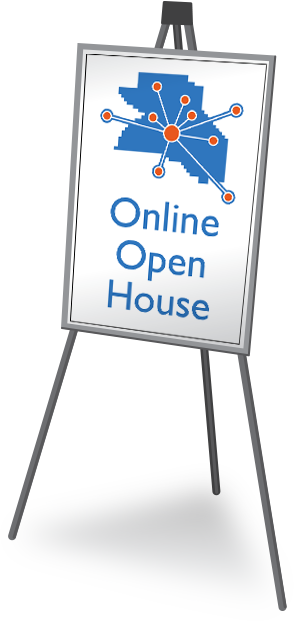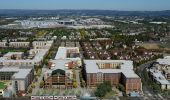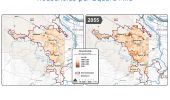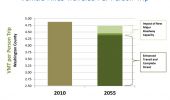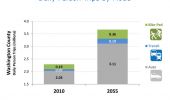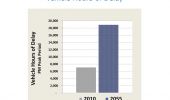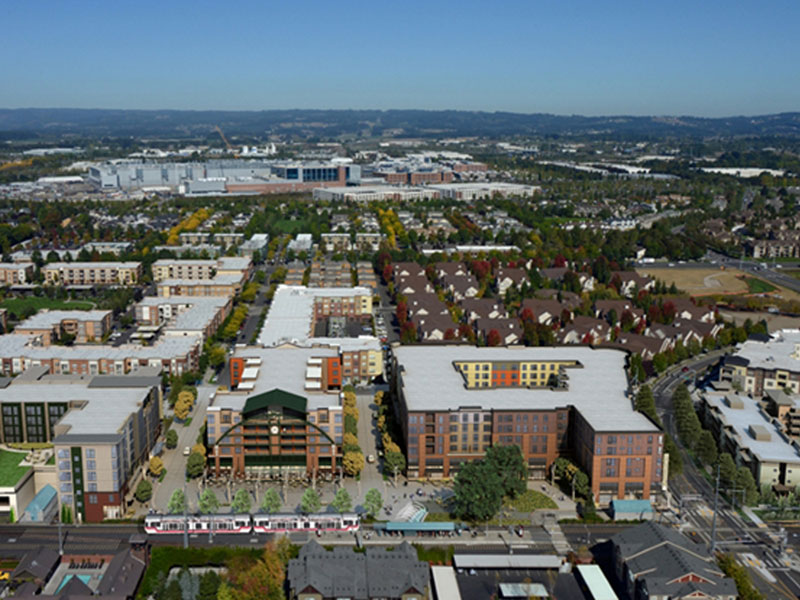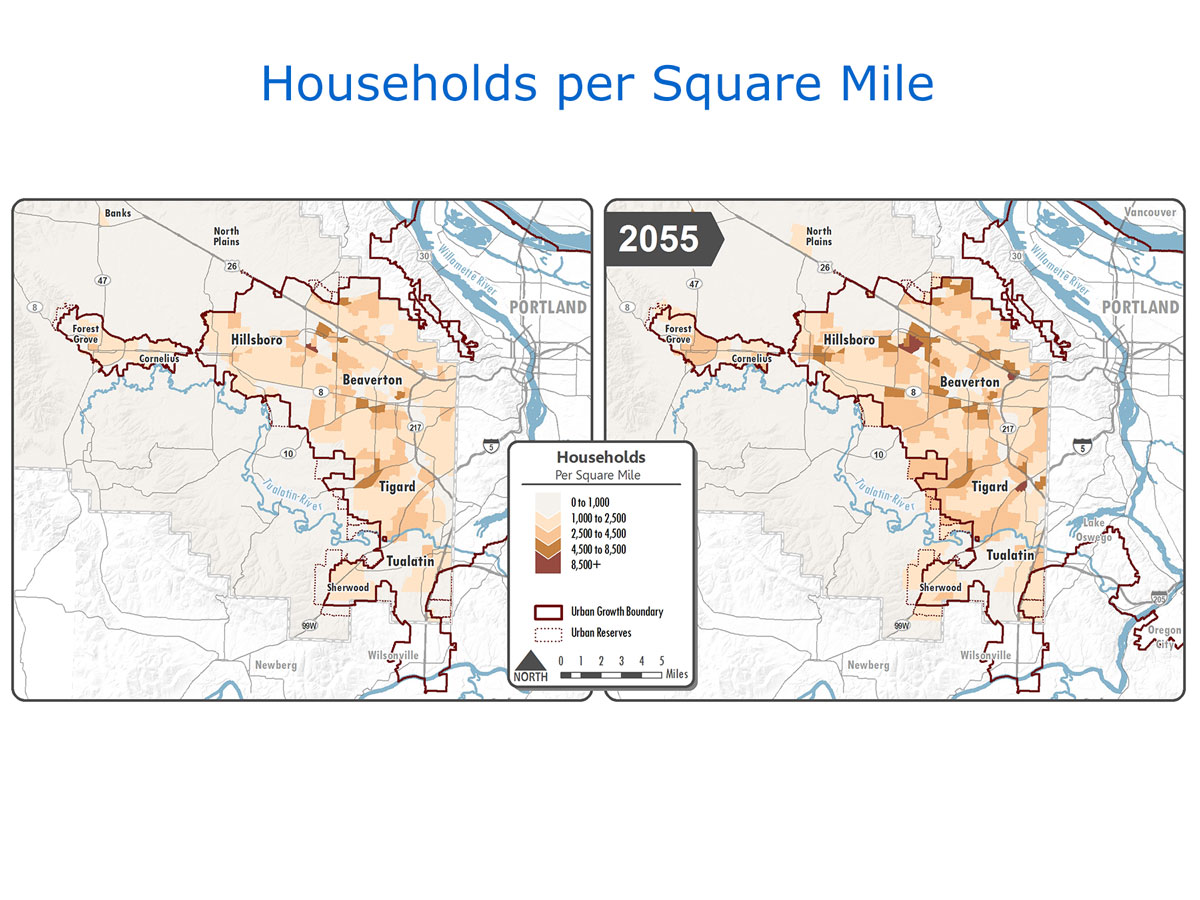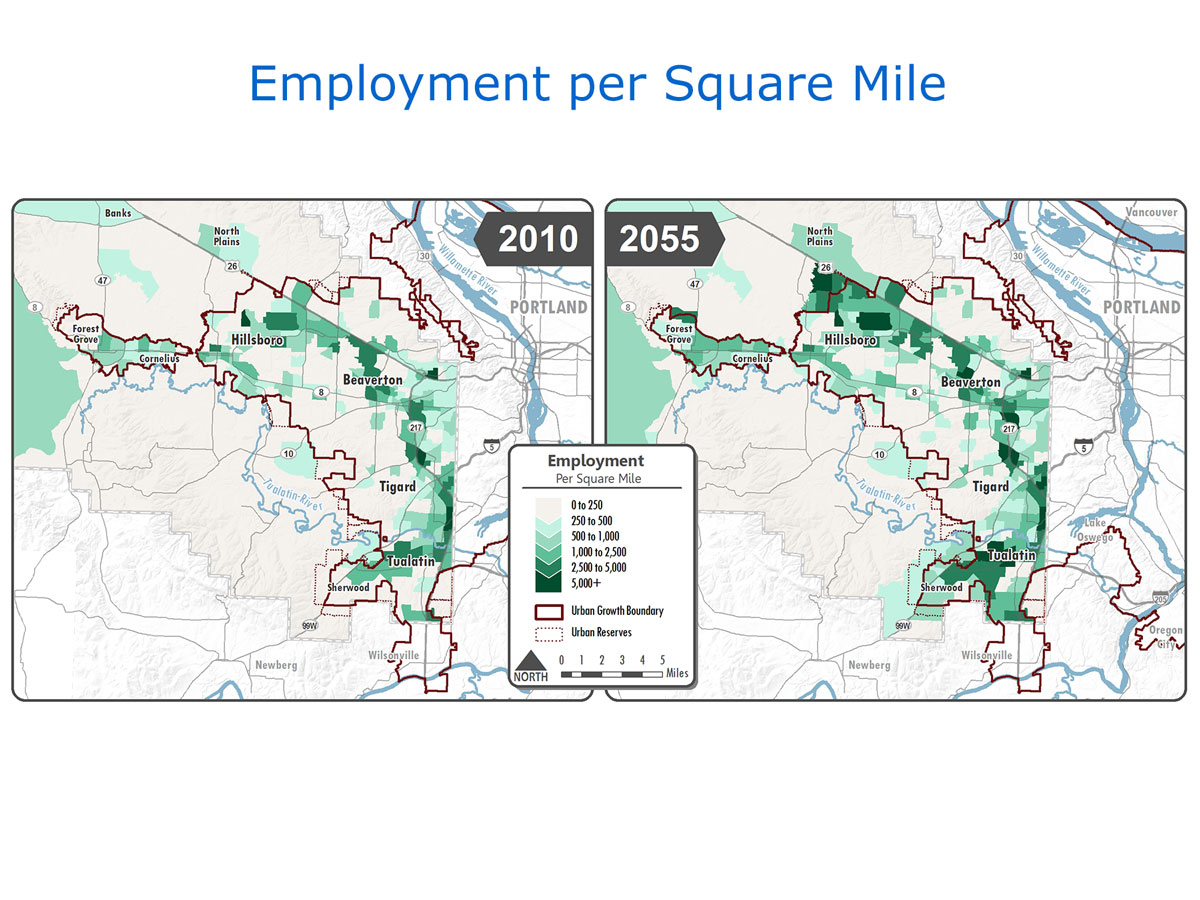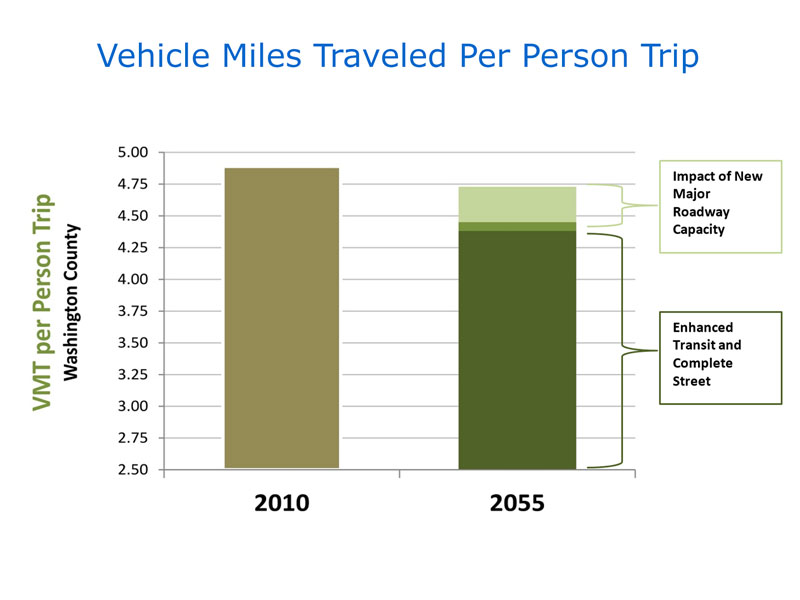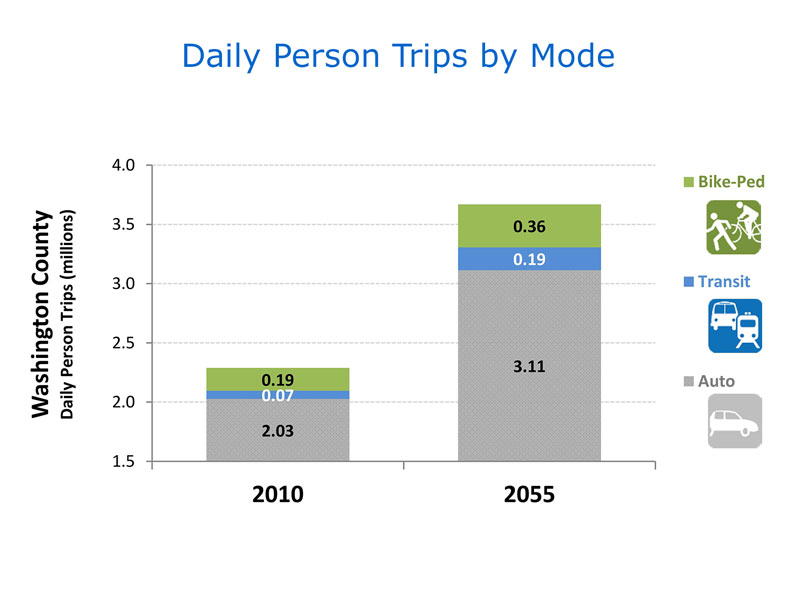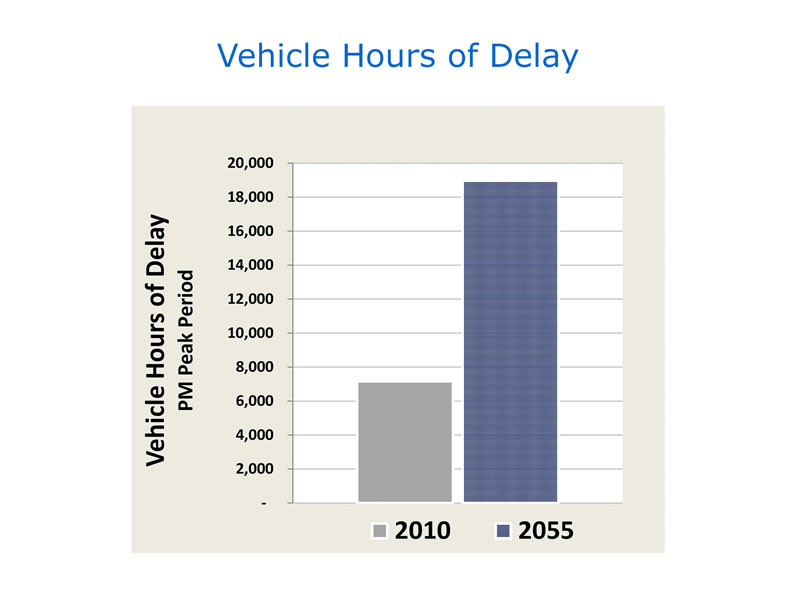Where do you want to go?





= Page includes questions or opportunities for comment.
The study reviewed past growth trends and developed future growth scenarios for a 40-50 year timeframe that reflects the development of adopted land use plans and areas designated for future urban development. The study collected values that were important to the community for use in considering tradeoffs between transportation investments.
Earlier in 2016, we asked the public to help identify potential transportation investments and ideas to study. We have completed an evaluation of these ideas and investments to see how well they meet anticipated future transportation needs and support community values.
Now, we are ready to share the results with you and hear your input about what we should study further.
We expect population and employment to grow.
We expect a 41-55% increase in population and a 100-150% increase in employment, depending on growth scenario assumptions. This is like adding at least the population of another Hillsboro, Beaverton and Tigard.
Areas such as downtown Beaverton, Tanasbourne, Tigard Triangle, and other centers are anticipated to continue to redevelop and become more urban. These places are expected to have a mix of residential, employment and commercial uses (similar to the Beaverton Round or Orenco Station), and will require people to drive less. The study found that with increased urbanization and trends in travel behavior, the number of vehicle miles traveled per person trip will continue to decline over time and will be less than in 2010. Transit, biking and walking trips are expected to more than double.
Traffic in 2055 will be much worse without major changes in how we live and travel, as well as major transportation investments.
- Today there are roughly 2 million trips per day made by car; we expect that to grow more than 50% by 2055.
- Drivers will experience severe congestion most of the day. This congestion will overflow onto major roads, and we’ll see more cut-through traffic on local roads.
- Traffic delay is expected to double and the number of lane miles exceeding capacity will increase seven-fold. This will negatively impact travel time and reliability and the ability to get freight trucks and commuters in and out of the County.
As millennials age and new generations emerge, things will be different. With help from the public, the Study Advisory Committee and local and regional agency partners, this study looked at hundreds of conceptual transportation strategies to support the County’s quality of life and economic health in the future. This was an opportunity to explore aspirational ideas and think outside the box. The study considered investing in all modes of travel—driving, biking, walking and transit— because there is no one, single solution to meet future travel demand.
Following are questions on some of the study’s key findings. You can find out more and offer additional input on specifics within each category by selecting the tabs on the following page.
Use the sliders to assign points to each transportation option area.
Programs to reduce vehicle tripsMore info... |
0 |
Smart TechnologyMore info... |
0 |
Enhanced Bicycle and Walking InfrastructureMore info... |
0 |
Enhanced TransitMore info... |
0 |
Enhanced Arterial NetworkMore info... |
0 |
New RoadwaysMore info... |
0 |
New Freeway LanesMore info... |
0 |
Total Spent: 0/28
- Improving access to essential destinations, such as work and school Not ranked.
- Improving traffic flow Not ranked.
- Providing alternatives to driving (such as transit, sidewalks and bikeways) Not ranked.
- Improving neighborhood livability Not ranked.
- Improving accessibility for low income households Not ranked.
- Protecting and enhancing the environment Not ranked.
- Improving reliability for freight and goods movement Not ranked.
- Improving safety for vehicles, pedestrians and bicyclists Not ranked.
- Improving public health Not ranked.
- Download full report(pdf, 12.8mb)
Click the tabs below to learn more...
Which of these options would you support exploring further to manage demand?
You may answer additional optional questions by clicking the topic areas on the left, or continue to the Next Steps page.
Self-driving cars could theoretically travel more closely together than today’s cars, allowing more cars to use the same road, reducing crashes and related delays. Because self-driving cars could reduce congestion on roads, this may simultaneously encourage people to drive more as roads open up. The study found that, if self-driving cars increase the capacity of the roads by 20%-40%, delay could be reduced by 11%-22%, but the total number of vehicle miles driven could increase by up to 55%-155%.
How strongly do you support the following statement?
You may answer additional optional questions by clicking the topic areas on the left, or continue to the Next Steps page.
The study also found that:
- Portland will continue to be the most significant transit market for trips to and from Washington County. Transit trips to Portland will more than double by 2055.
- Light rail trains would need to run every six minutes or better in both the US 26 and the I-5 corridors to meet demand at peak load points.
- By providing faster light rail service and more park and rides, demand for transit could increase up to 20% more between Hillsboro and Portland.
- Buses will experience the same congestion levels as other cars and trucks on the road, unless investments are made that prioritize buses.
- An Increasing, but smaller, demand is expected from Marion, Columbia and Yamhill counties.
Which of the following would you support exploring further to meet the county’s increasing transit demand?
You may answer additional optional questions by clicking the topic areas on the left, or continue to the Next Steps page.
Which of the following bicycle/pedestrian improvements would you support exploring further?
You may answer additional optional questions by clicking the topic areas on the left, or continue to the Next Steps page.
The study also found that:
- Expansion of existing arterials, such as Roy Rogers Road and Cornelius Pass Road, can help traffic flow but will not add capacity to meet all traffic demand.
- New arterial connections, such as connecting arterials for a route around Cooper Mountain between Roy Rogers Road and Cornelius Pass Road south of TV Highway could reduce traffic volumes on adjacent arterials, such as 175th, up to 20%, allowing other arterials to serve a more localized function.
- Additional design treatments, access management and passing lanes on Highway 219, Cornelius Pass Road and other roads could improve safety but are likely to have little impact on reducing delay.
- Slower traffic speeds, more crossings, sidewalks and other amenities in mixed use centers areas with high pedestrian traffic can promote walkability, improve safety and support community goals but reduce vehicle capacity through these areas.
What additional arterial improvements would you support exploring further?
You may answer additional optional questions by clicking the topic areas on the left, or continue to the Next Steps page.
The study also found that:
- A new “northern connector” between US 26 and Hwy 30 with a new bridge across the Willamette River to Columbia Blvd would attract 60% of the trucks traveling on US 26 through the tunnel, shorten the truck trip and improve access for trips to the industrial areas and I-5 North and reduce traffic on Cornelius Pass and Germantown roads.
- A new limited access roadway between US 26 at Hillsboro and I-5/I205 at Wilsonville would reduce vehicle delay and shift traffic from other roads, such as TV Hwy, Hwy 219, and local roads, allowing use of these existing roads for agricultural and local traffic. Traffic demand is higher for the roadway located within a more urban area than for a western location in the rural area.
- Faster speeds on the new roadways would increase vehicle trips and increase safety risk. Construction for new roadways would increase environmental impacts with 800 acres of roadway through natural, agricultural and developed communities.
Which new roadway investments would you support exploring further?
You may answer additional optional questions by clicking the topic areas on the left, or continue to the Next Steps page.
The study found that:
- Adding a lane in each direction on these freeways (I-5, US 26, I-205, and Highway 217) and managing these lanes for trucks, buses and high occupancy vehicles (HOV) could reduce delay for general purpose traffic by up to 15% due to the added capacity and up to 50% for trucks due to the exclusive truck lanes.
However, added capacity would be readily consumed by additional vehicle traffic and freeways would remain congested, though traffic on parallel arterials would be reduced.
Faster speeds with the added lanes would increase the total number of vehicle miles traveled, increase crash risk and could contribute to greenhouse gas emissions, unless mitigated by safer and cleaner vehicles.
Which new freeway lane investments would you support exploring further?
You may answer additional optional questions by clicking the topic areas on the left, or continue to the Next Steps page.
Final Questions
Mailing list (Optional)
Provide the following optional contact information if you would like to be added to the project mailing list.
Demographic Information (Optional)
This study is requesting demographic information to evaluate the effectiveness of public outreach activities. The identity of individuals is kept confidential. The results are reported as totals only, and used solely to help improve future community engagement. Providing this information is voluntary and optional.


